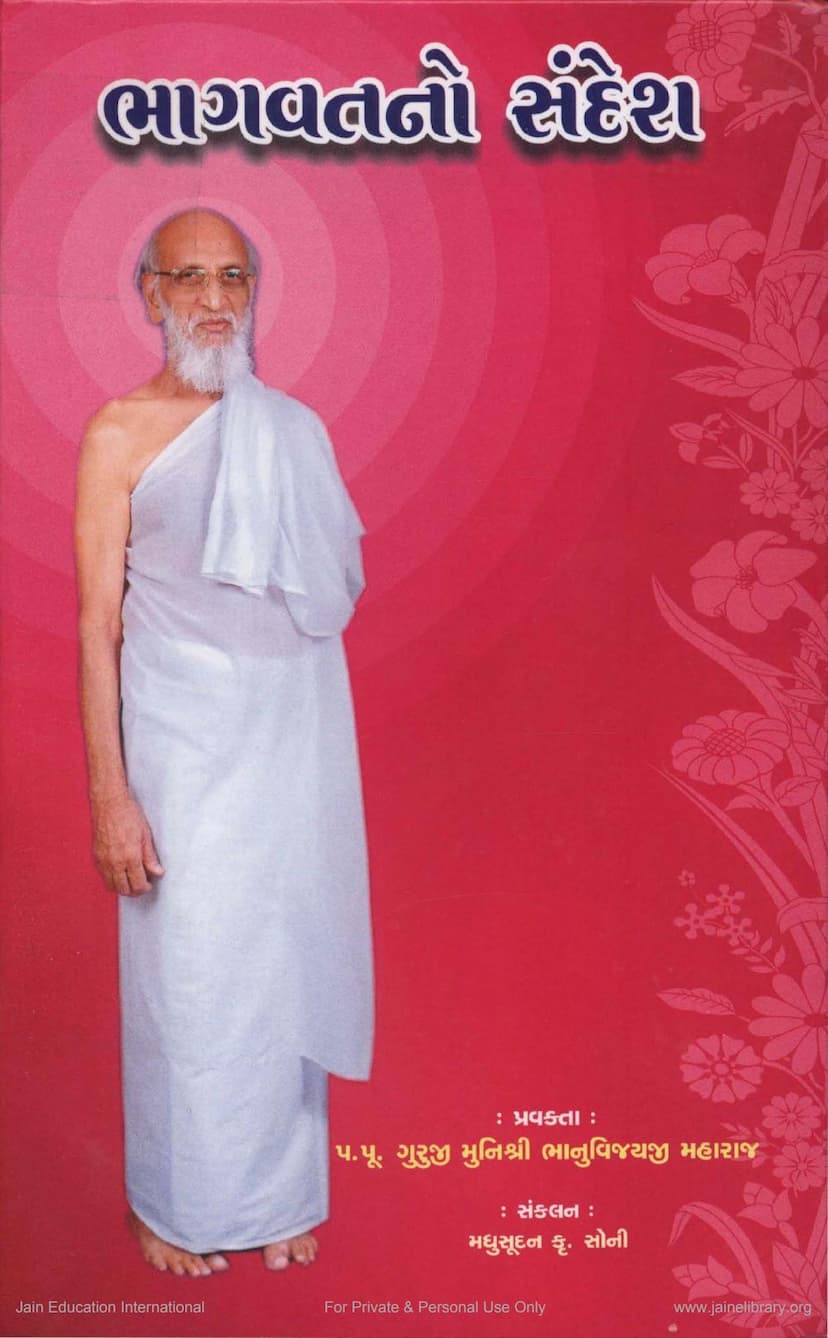Bhagavatno Sandesh
Added to library: September 1, 2025

Summary
Here is a comprehensive summary of the Jain text "Bhagavatno Sandesh" by Bhanuvijay:
Book Title: Bhagavatno Sandesh (The Message of the Bhagavat) Author: Muni Shri Bhanuvijayji Maharaj Publisher: Sarvamangalam Ashram Sagodiya Catalog Link: https://jainqq.org/explore/004651/1
This book, "Bhagavatno Sandesh," is a compilation of discourses delivered by the esteemed Jain monk, Muni Shri Bhanuvijayji Maharaj. The discourses, compiled by Madhusudan K. Soni, delve into the profound teachings of the Bhagavat Purana, interpreting its spiritual and philosophical essence through a Jain lens.
Key Themes and Teachings:
The book emphasizes the Bhagavat Purana as a foundational text for spiritual growth, presenting its narratives and philosophical insights as a guide for living a meaningful and virtuous life. The core message revolves around:
- Understanding the True Nature of Reality: The text highlights the distinction between the eternal Atman (soul) and the transient material world (Pudgal, Prakriti, Maya). It stresses that true happiness and peace are not found in external possessions or worldly pleasures but within the self, residing in the Atman. The allure of material things is likened to a mirage in the desert, offering fleeting satisfaction.
- The Path to Liberation (Moksha): The ultimate goal presented is liberation from the cycle of birth and death (Samsara). This is achieved through self-realization, understanding the Atman, and detachment from worldly attachments and desires.
- The Importance of Self-Effort and Sadhana: The book underscores the Jain principle of self-reliance in spiritual progress. The teachings of Lord Mahavir and Lord Krishna, "Uplift yourself," emphasize that individuals are responsible for their own liberation. This necessitates diligent practice (Sadhana) through various spiritual disciplines.
- The Power of the Mind: The mind is identified as both the cause of bondage (Samsara) and the means to liberation (Moksha). When the mind is attached to sensory objects and worldly desires, it leads to bondage. Conversely, when the mind is directed towards the Divine (Paramatma) through devotion, contemplation, and detachment, it leads to liberation. Controlling the mind through practices like meditation and mindfulness is crucial.
- The Role of Sadvidya and Sadvidya: The text stresses the paramount importance of associating with wise and virtuous individuals (Satsang) and studying scriptures under the guidance of a true Guru (Sadguru). These associations help purify the mind, overcome negative tendencies (like Kama, Krodha, Lobha, Moha), and cultivate spiritual understanding.
- The Essence of Dharma: Dharma is not merely ritualistic action (Karmakand) but an internal state of consciousness. True Dharma involves ethical conduct, moral values, and the cultivation of inner virtues like compassion, non-violence, truthfulness, and detachment. The Bhagavat Purana is presented as a guide to living a life aligned with these principles.
- Living a Life of Detachment and Equanimity: The discourses advocate for a balanced approach to life, accepting both joys and sorrows with equanimity. While acknowledging the impermanence of worldly experiences, the importance of living in the present moment with awareness is emphasized. Detachment from the fruits of actions and surrendering them to the Divine is presented as a key to inner peace.
- The Transformative Power of Bhakti (Devotion): While acknowledging the paths of knowledge (Jnana) and action (Karma), the book highlights Bhakti as the most accessible and potent path for spiritual realization, especially in the current age. True Bhakti involves complete surrender to the Divine, letting go of the ego, and seeing the Divine presence in all beings.
- The Concept of Karma and its Role: The text touches upon the law of Karma, explaining that our actions have consequences that shape our present and future experiences. Understanding Karma helps in accepting life's circumstances and making conscious choices to create positive future outcomes.
- The Bhagavat as a Guide: The Bhagavat Purana is presented not just as a scripture but as a living guide that offers solutions to life's challenges and illuminates the path to spiritual fulfillment. Its stories and teachings, when understood and practiced, can lead to a profound transformation of one's life.
The Role of Muni Shri Bhanuvijayji Maharaj:
Muni Shri Bhanuvijayji Maharaj, born in 1931, embarked on his spiritual journey at a young age. He is renowned for his profound understanding of Jain scriptures and various Indian philosophies. His unique perspective, rooted in the Jain principle of Anekantavada (multi-sidedness), allows him to transcend sectarianism and appreciate the underlying unity in different philosophical systems. He advocates for a life rich in ethical conduct (Shila) and spiritual pursuit (Adhyatmikta).
Establishment of Sarvamangalam Ashrams:
The book details the significant work undertaken by Muni Shri Bhanuvijayji Maharaj in establishing the Sarvamangalam Ashrams. The Sarvamangalam Ashram in Sagodiya and the Sarvamangalam Parivar Ashram in Patan are highlighted as centers of spiritual learning, charitable activities, and community service. These Ashrams have not only provided spiritual guidance but also engaged in significant philanthropic work, including disaster relief and educational initiatives.
Compilation and Publication:
The publication of "Bhagavatno Sandesh" is a testament to the collective effort of many individuals who were inspired by Muni Shri Bhanuvijayji Maharaj's teachings. The detailed acknowledgments and donor lists in the book reflect the widespread appreciation for his spiritual work and the desire to disseminate his wisdom.
In essence, "Bhagavatno Sandesh" serves as a comprehensive spiritual manual, drawing from the Bhagavat Purana and interpreting its timeless wisdom through the profound insights and compassionate guidance of Muni Shri Bhanuvijayji Maharaj, making it accessible and applicable to the lives of contemporary seekers.